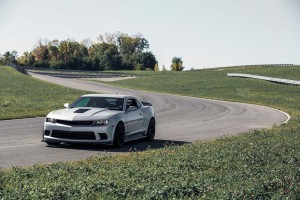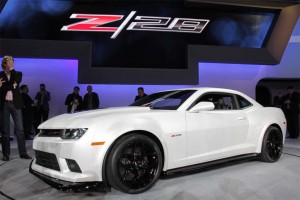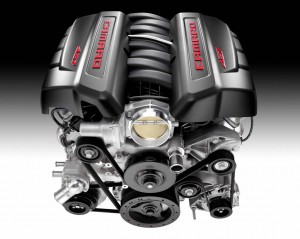Chevy dropped a bombshell earlier this year when it announced the revival of the formidable Z28, a 500-plus-horsepower version of its 2014 Camaro. Now, with the track-ready coupe ready to roll into showrooms, the maker is hoping to whet – make that “wet” – potential buyers’ appetite.
The General Motors division took one of the new Camaro Z28s over to Germany for a run around the grueling Nurburgring circuit. And not only did it deliver an impressive time of 7:37.47 in a drizzly mist, but it beat the numbers for the Porsche 911, a model generally considered much more at home on the tight and twisty ‘Ring than a classic American muscle car.
While the costly Z28 is likely to become little more than a niche model, Chevy is betting it will put a halo around the 2014 Camaro’s more mainstream versions – critical in reversing a 6% slide that could let the Ford Mustang regain its pony car sales crown for 2013 after lagging the Camaro since its re-launch a few years back.
The heart of the new 2014 Camaro Z28, which will go on sale in early 2014, is a 7.0-liter LS7 engine beefed up with such high-performance components as titanium intake valves and connecting rods, CNC-ported aluminum cylinder heads and a forged-steel crankshaft. Put them all together and the track-ready edition gets an SAE-certified rating of 505 horsepower and 481 pound-feet of torque, according to Al Oppenheiser, Camaro chief engineer.
(Z28 makes a surprise debut at the NY Auto Show. Click Here for more.)
A six-speed manual transmission is the only gearbox offered and power is distributed to the rear wheels via a limited-slip differential featuring a helical gear set, rather than traditional clutch packs, Oppenheiser said.
Oppenheiser said the new design enables the driver to apply more power and get through corners faster by making the most of the capability of its individual-wheel antilock brake function during corner entry braking, mid-corner speed and corner-exit traction.
The Z28 is capable of 1.08 g in cornering acceleration, due to chassis revisions meant to hold it hard onto the pavement, and has more stopping power thanks to Brembo carbon-ceramic brakes capable of 1.5 g in deceleration, and consistent brake feel lap after lap.
(Muscle cars are back. Click Here to check out some of the latest>)
The naturally aspirated Z28 weighs 300 pounds less than the supercharged Camaro ZL1, with changes throughout the car ranging from lightweight wheels to thinner rear-window glass. Considering the emphasis on track performance, air-conditioning is available, but only as an option.
Its recent run on the Nurburgring showed the Z28 lapping four seconds faster than the Camaro ZL1, while beating published times for both the Porsche 911 Carrera S and the Lamborghini Murcielago LP640, Oppenheiser noted.
“Adam Dean, the development driver for Z28, did a heroic job driving in deteriorating conditions. Based on telemetry data from our test sessions, we know the Z28 can be as much as six seconds faster on a dry track,” Oppenheiser suggested.
(Mustang and Camaro resume their epic, decades-long battle. Click Here for the story.)
The team spent a week at the ‘Ring as part of the Z28’s performance-validation regimen, accumulating a total of 10 hours and nearly 1,000 miles on the track as the car completed what GM development engineers call the “24 Hour Test.”
The 24-Hour Test is actually a collection of different segments over the course of several days – and even at different tracks – to evaluate performance in carefully monitored increments.
In all, the Z28 went through 24 hours of track testing, and the only mechanical changes allowed were the replacement of brakes and tires. Each valid test lap had to be run within 2% of a target lap speed to count toward the 24-hour total, Oppenheiser said.
GM devised the 24-Hour Test in the early 1990s for the fourth-generation Corvette. Back then, the 300-horsepower 2-seater was Chevrolet’s most powerful vehicle, and the 24-Hour Test measured 15 channels of data. Today, 130 channels are tracked.
“Passing the 24-Hour Test is a requirement for all cars we call ‘track capable,’” said Wayne McConnell, director of global vehicle performance.
Paul A. Eisenstein contributed to this report.




It sounds like the new Z28 will be a cool car but it certainly is not in the same category as a Porsche Carrera S. While the performance numbers might be similar, the Porsche achieves it with only 400 HP. In addition the Porsche could be flogged around the Nurburgring for 24 hours straight and still be just fine.
I doubt any consumers looking to buy a Porsche 911 series are Z28 candidates or vice versa. These are both exceptional cars but very different cars for different enthusiasts and applications.
@JorgeM
What do you mean not in the same category as the Porsche as in the $150,000 price category? Also you state the performance numbers are similar? Wrong the Z28 beats the Porshce. As far as the Porsche achieves it with 400hp the Z28 is almost 600lbs heavier. And the Z28 beat the ZL1 which has more horsepower as well as the Murcielago LP640 which has much more HP. Making a generalized statement that has no proof that the Porsche could be flogged for 24hrs straight and be just fine is also your opinion which is most likely wrong along with your other statements. The Z28 is a track, performance, enthusiast certain type of application car… the Porsche is a what according to you?
Easy to tell you’re a Muscle Car, not a Sports Car fan, Konabear. The cars ARE too diverse for one to ‘beat’ the other. The only way to understand is to have experienced both. Take them both across 10 miles of N.C. or Colorado mountain roads, not even exceeding ‘7/10ths’, and the difference would be clear. But then include the $$, and they are not even from the same universe! BTW, if you haven’t googled for motortrend’s video on youtube or the ENTIRE lap in the Z28, do it now (with good speakers!).
@heyfred3000
Not so fast on your assumption. I am a Porsche fan, Muscle car fan, Sports car fan, and a Truck fan. My family has owned several 911’s. I’m not sure what you mean too diverse to “beat” the other. Both Z28 and 911, went around the same track, the one that is the standard, what is measured amongst all sports, performance, muscle whatever you want to call it cars in the world. And the Z28 has a faster lap time PERIOD. Therefore it BEAT the 911. In auto racing it’s the fastest lap time that wins. Speaking of racing and to clarify on both yours and the previous post, that the Porsche and Z28 are too diverse and different, etc. Perhaps you guys should do a little research, brush up on your automotive history. The “muscle cars” ie Mustangs, Camaros started out as race cars, sports cars, track cars whatever term you want to use, just as Porsche has a racing heritage with the 911.
http://www.67z28.com/history.htm
So really the only diversity here and differences that I see besides the engineering approach each took, front engine vs. rear, etc. is one is made in Germany and has a much higher price tag. Along with perceptions from people like yourself and JorgeM that the 911 must be better, different or have different applications and there could be no way a Z28 could ‘beat’ a Porsche in any way shape or form because its not in the same category, “too diverse”…or should I repeat price and perception.